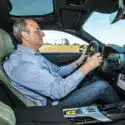BRM P261
Comparing the Connaught to the BRM is akin to contrasting a bread knife to a scalpel. Both are brilliant at what they do, but the P261 appears impossibly small and sharp next to the A-type, a car which, in its fundamental design differed in no great way to the last of the pre-war designs.
We should not be surprised. For a start, the BRM was a true front runner, taking Graham Hill to within one point of the championship in 1964; more significantly, this now was the era of the monocoque chassis and, critically, the mid-mounted engine. The BRM then, is the archetypal ’60s F1 car; there is little by way of trick technology (the most successful BRMs were always the least innovative). Just a simple cigar-shaped body clothing the by now familiar monocoque chassis, powered by a screaming 1.5-litre V8 producing some 220bhp, way up at 11,000rpm, approximately double the revs of the Connaught. Its gearbox has six ratios and, like almost everything else on the car save the tyres, was designed and built in-house by BRM.
Unlike so many of its ilk, it’s a reasonably comfortable car to drive and one which at once puts the driver at ease. This ex-Hill example is currently fitted with a 2-litre Tasman-specification version of the engine with 275bhp and, in a car weighing just 470kgs, ensures acceleration beyond that of any production road car ever made. It’s flexible too, strong from 5000rpm and shrieking up to a conservative 10,500rpm limit. Happily, it is not a museum piece either, but a hard-used campaigner, winning races to this day. And that is how it feels: there is no slack anywhere other than in the brake pedal which has a disconcertingly long travel, but apparently that’s the way they were.
The steering is light but not absurdly so, as in some of the very first 1.5-litre F1 cars, while the M-section Dunlops grip tenaciously.
Best of all though, you can do what you like with it; you can boot it, balance it or just drive within its broad limits and it will always say the same thing to you: “this is fine but if you go faster you’ll have even more fun.” And I don’t doubt that’s the case. The P261 is one of those cars which inspires perhaps too much confidence in its driver. It is so full of promise and reassurance that there is some temptation to forget its value, its rarity (only four were ever made) and heritage in order to see what happens at qualifying pace. But risking automotive icons is not what we’re here for and I was more than happy to return to the pits convinced that the 1.5-litre cars from this era have been unfairly maligned. For sure this BRM has more power than it would have done in its day but that is not really the point.
These cars are, to me, the purest Formula 1 racers of them all; their passing at the end of 1965 represented the turning point where designers stopped taking things off Fl cars to make them go faster and, instead started adding them on. They gained more rubber, then wings, then advertising. These are the lightest F1 cars of all time and the most unadulterated. Driving just doesn’t get any purer than this. Andrew Frankel

